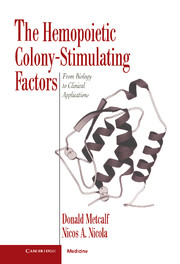Book contents
- Frontmatter
- Contents
- Preface
- 1 Historical introduction
- 2 General introduction to hemopoiesis
- 3 Key techniques in analyzing hemopoiesis
- 4 Biochemistry of the colony-stimulating factors
- 5 Biochemistry of the colony-stimulating factor receptors
- 6 Molecular genetics of the colony-stimulating factors and their receptors
- 7 Biological actions of the colony-stimulating factors in vitro
- 8 The biology of colony-stimulating factor production, degradation, and clearance
- 9 Actions of the colony-stimulating factors in vivo
- 10 Role of the colony-stimulating factors in basal hemopoiesis
- 11 Actions of the colony-stimulating factors in resistance to infections
- 12 Role of the colony-stimulating factors in other disease states
- 13 The colony-stimulating factors and myeloid leukemia
- 14 Clinical uses of the colony-stimulating factors
- 15 Conclusions
- References
- Index
3 - Key techniques in analyzing hemopoiesis
Published online by Cambridge University Press: 04 August 2010
- Frontmatter
- Contents
- Preface
- 1 Historical introduction
- 2 General introduction to hemopoiesis
- 3 Key techniques in analyzing hemopoiesis
- 4 Biochemistry of the colony-stimulating factors
- 5 Biochemistry of the colony-stimulating factor receptors
- 6 Molecular genetics of the colony-stimulating factors and their receptors
- 7 Biological actions of the colony-stimulating factors in vitro
- 8 The biology of colony-stimulating factor production, degradation, and clearance
- 9 Actions of the colony-stimulating factors in vivo
- 10 Role of the colony-stimulating factors in basal hemopoiesis
- 11 Actions of the colony-stimulating factors in resistance to infections
- 12 Role of the colony-stimulating factors in other disease states
- 13 The colony-stimulating factors and myeloid leukemia
- 14 Clinical uses of the colony-stimulating factors
- 15 Conclusions
- References
- Index
Summary
It is useful at this stage to comment on some of the major techniques used in analyzing cellular hemopoiesis, because an understanding of what each documents and what its limitations are is necessary to assess the importance or relevance of much that will follow in the discussion of the colony-stimulating factors.
Identification and enumeration of stem cells
Repopulating cells
The most ancestral stem cells can be identified and defined only by their capacity to repopulate for a sustained period all hemopoietic and lymphoid tissues of an irradiated recipient (Hodgson and Bradley, 1979; Harrison, 1980). To identify progeny of the injected repopulating cells, such assays require markers that, ideally, can detect cells in all major lineages, whether dividing or not. Thus, the use of markers such as Ly1.1 and Ly1.2 is ideal, permitting work with otherwise syngeneic donor and recipient mice. Sex markers and, to a lesser degree, marker chromosomes such as the T6 are also useful. With purified stem cells, as few as 30 cells can permanently repopulate an animal, often with evidence that the repopulating tissue is derived from a single cell. However, many such animals are chimeras because surviving host cells also contribute to hemopoiesis. The major disadvantage of this in vivo repopulation assay is that quantification is virtually impossible, and the assay cannot distinguish even two- to fivefold changes in the number of repopulating cells.
In vitro long-term culture-initiating cells
These stem cells characteristically form cobblestone areas of primitive hemopoietic cells on appropriate supporting underlayers. Quantification of such cells is possible by limit dilution assay (Ploemacher et al., 1991), and the technique can be applied to both human and mouse cells.
- Type
- Chapter
- Information
- The Hemopoietic Colony-stimulating FactorsFrom Biology to Clinical Applications, pp. 33 - 43Publisher: Cambridge University PressPrint publication year: 1995



